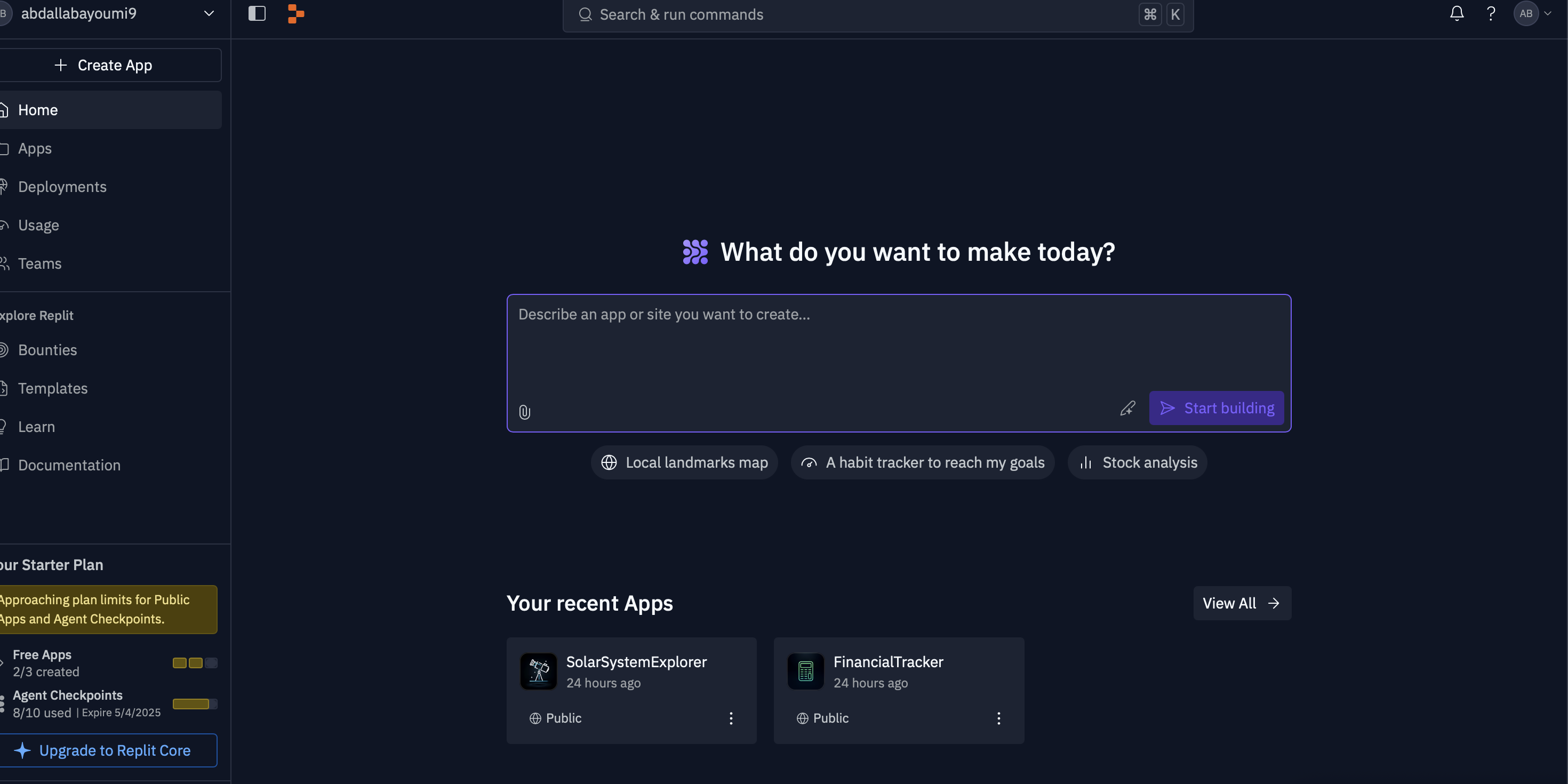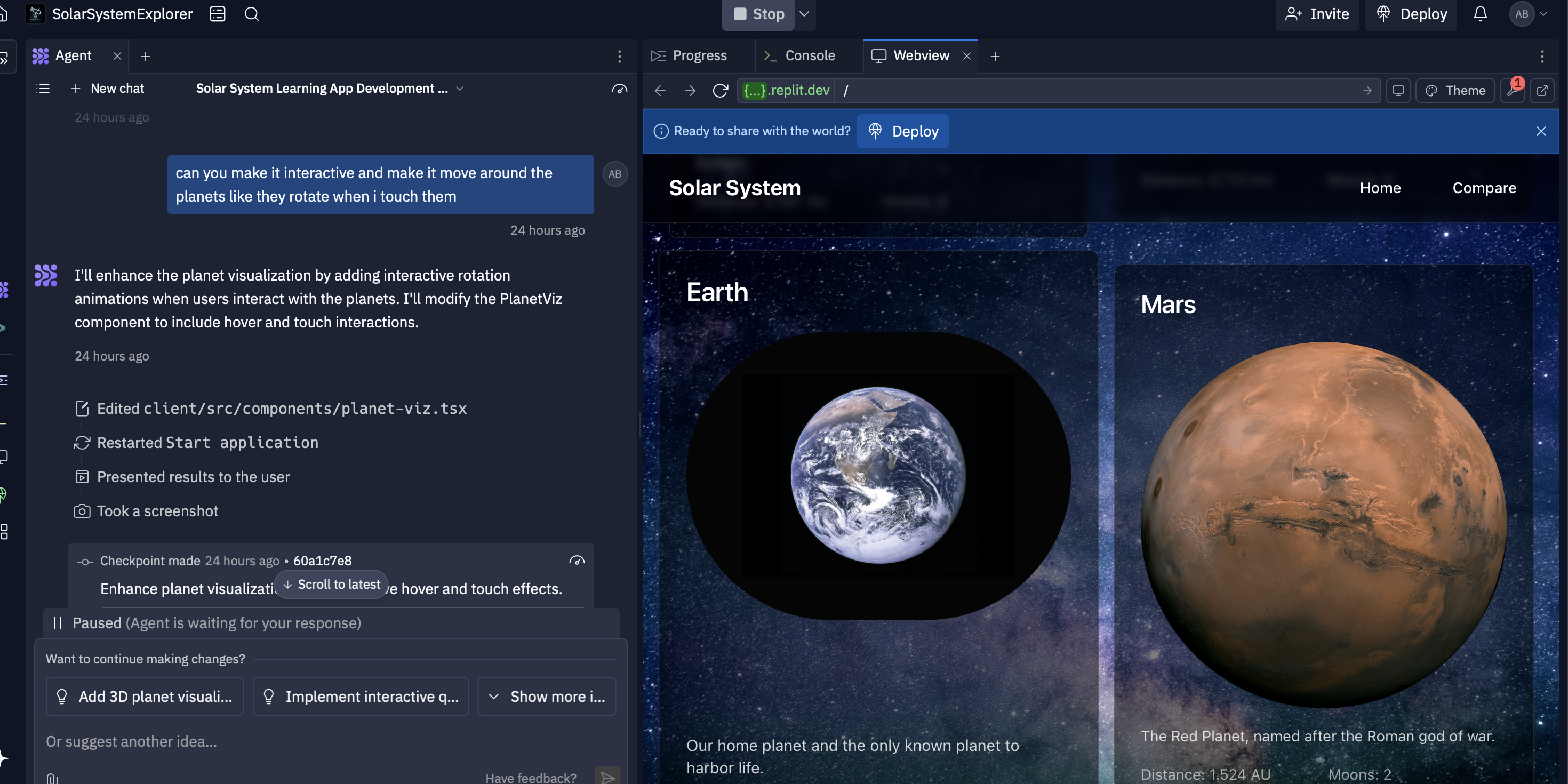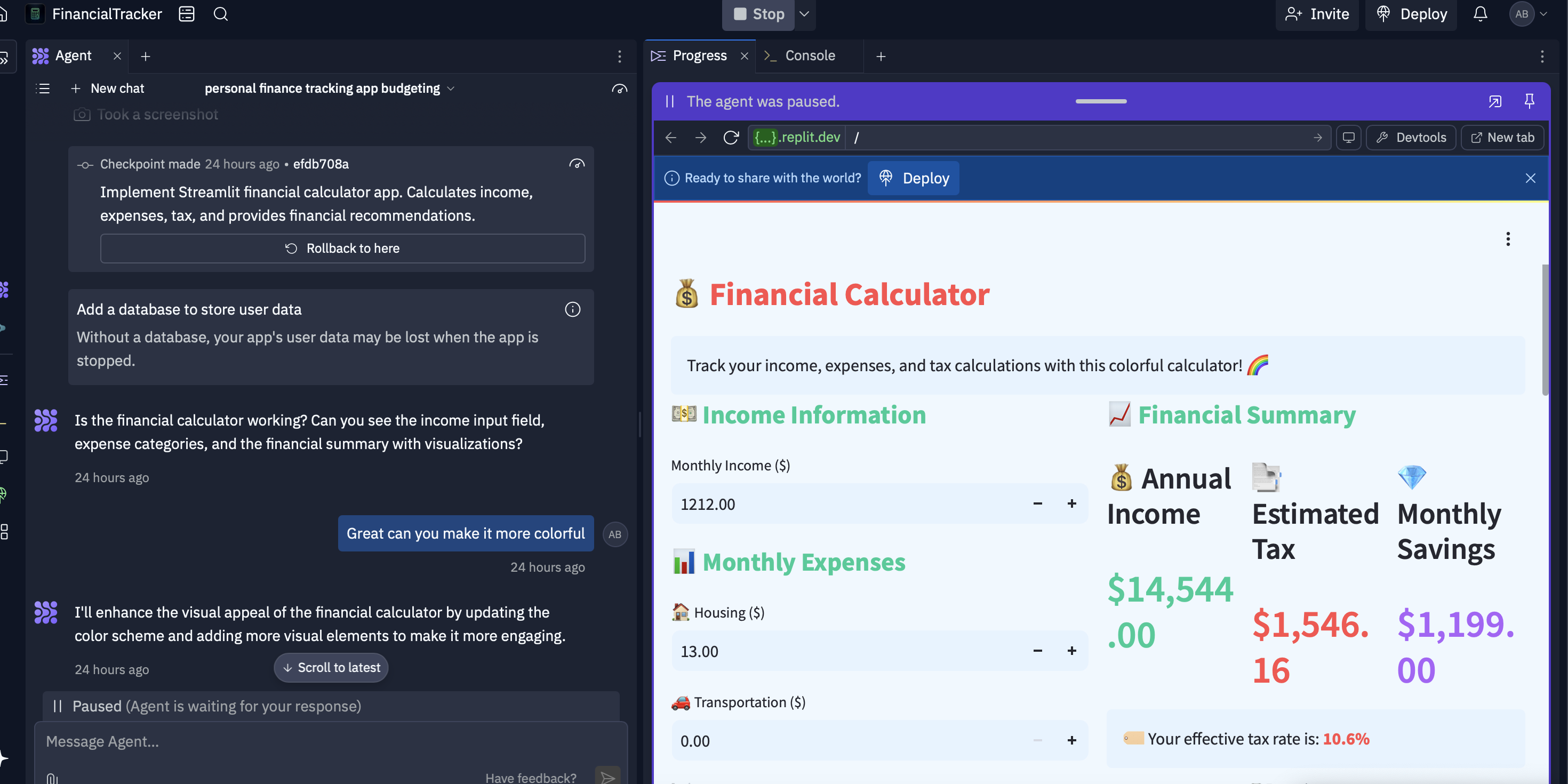Replit Agent: A Comprehensive Review of the AI App Builder
We’ve all had that moment: "What if there was an app that…?” Maybe it’s "Instagram for dog memes” or "Uber but for babysitters.” The idea feels so obvious. But then… how do you actually build it?
Coding is hard. Learning it takes time. Hiring developers costs money. Most of us get stuck at the starting line. Our ideas stay trapped in notes, napkins, or late-night texts to friends.
Replit Agent tries to fix this.
Think of it like a translator. You say, "I want an app where people trade houseplants,” and it helps you build it—step by step. It writes code when you’re stuck, fixes mistakes, and explains things in plain English.
Is it magic? No. But it’s a tool to finally start building, not just dreaming.
Maybe now, the gap between "idea” and "app” isn’t so scary after all.

What is Replit Agent
So, what is Replit Agent? Think of it as your digital workshop partner. No coding skills? No problem. You describe your app idea in plain English ("I need a task manager with boards and deadlines”), and the Agent does the heavy lifting:
- Translates your vision into a step-by-step plan.
- Suggests tools (like React for sleek interfaces or Python for quick web apps).
- Builds a prototype in real time, piece by piece, while you watch.
- Lets you tweak it live: "Make that button blue” or "Add a progress chart.”
The result? A working, shareable prototype—ready to test, pitch, or polish into a full product.
It’s not magic. But it is a shortcut. For the first time, you don’t need to be a coder to bridge the gap between "I have an idea” and "I made an app.” Replit Agent hands you the tools to build, not just brainstorm.
Your move, coffee-stained napkin sketches.
Hands-On with the Agent: From Idea to Interactive Demo
Hypothetical scenarios can spark curiosity, but true innovation reveals itself in action. Let’s peel back the layers of abstraction and dive into real-world applications of Replit Agent—a tool that transforms how we debug, build, and iterate. Through firsthand experience and demonstrations, I witnessed its potential not as a theoretical concept, but as a collaborative partner in problem-solving. Below, I dissect two pivotal examples that showcase its transformative power.
Case Study 1: The Solar System Image Rescue Mission
The Problem: In a planetary education app, a broken Mars image threatened user engagement. For developers, such issues often trigger tedious debugging: sifting through code, validating URLs, or troubleshooting paths.
The Agent’s Workflow:
- Conversational Debugging: A simple message—"image is broken”—initiated the process. The Agent acknowledged the issue and formulated a plan: "Fix Mars, verify all planetary images.”
- Precision Code Edits: It autonomously located the corrupted data file, updated the URL, and restarted the app.
- Safety Nets & Iteration: Built-in checkpoints allowed rollbacks at any stage. When the first fix failed (Mars still MIA), the Agent pivoted, sourcing a high-resolution NASA image instead.
- Result: A restored solar system, with Mars gleaming prominently—all achieved through natural language collaboration.

Why This Matters:
This wasn’t just a bug fix. It exemplified streamlined debugging: the Agent handled code navigation, error diagnosis, and iterative testing, freeing the developer to focus on higher-level goals.
Case Study 2: Building a Financial Calculator—From Vision to Reality
The Challenge: Transforming a vague idea ("Calculate income, expenses, and tax rate”) into a functional app traditionally demands hours of setup, coding, and debugging.
The Agent’s Approach:
- Concept to Blueprint: The Agent proposed a Streamlit-based app with Python logic, Plotly visualizations, and interactive UI elements—all derived from a single prompt.
- Autonomous Development: It generated:
- Configuration files
- Calculation logic (tax rates, savings)
- Dynamic visualizations (expense pie charts)
- Library installations (Streamlit, Plotly)
- Iterative Refinement: A follow-up request—"Make it more colorful”—triggered theme adjustments and CSS styling, proving its capacity for creative iteration.

Why This Matters:
This wasn’t just code generation. It demonstrated end-to-end app development—translating abstract ideas into polished tools with minimal human intervention.
The Bigger Picture: A Paradigm Shift in Development
These case studies aren’t isolated wins; they signal a seismic shift in software creation:
- Speed: Tasks that once took hours now unfold in minutes.
- Accessibility: Natural language lowers barriers for non-experts.
- Collaboration: The Agent acts as a co-developer, handling grunt work while humans steer strategy.
Imagine a future where developers spend less time debugging and more time innovating. Replit Agent isn’t just a tool—it’s a glimpse into that future.
Real-World Applications: Beyond Internal Tools and Dashboards
Dashboards and checklists have their place, but let’s zoom out for a moment. Is Replit Agent merely a novel tool for hobbyists, or does it hold genuine promise in the real-world arena of product development? The answer isn’t just "yes” — it’s a clarion call for transformation. From scrappy startups to enterprise giants, Replit Agent is poised to redefine how we build, innovate, and scale. Here’s how.
Startups: From Idea to MVP at Warp Speed
For bootstrapped founders surviving on grit and caffeine, Replit Agent could obliterate the traditional barriers to MVP development. Validating a concept and securing investor buy-in no longer requires months of coding or draining funds on outsourcing. Imagine a founder with a bold vision — but limited technical expertise — crafting a functional prototype in days, not months. This tool turns the idea-validation phase into a sprint, enabling rapid iteration based on real user feedback before burning through seed capital. In the startup world, speed isn’t just an advantage — it’s survival.
Empowering Citizen Developers: Democratizing Tech in Enterprises
The true revolution? Unleashing non-technical talent to solve their own problems. Marketing leads, operations experts, and sales strategists could build custom tools tailored to their workflows — no more waiting for overburdened IT teams.
- Custom CRM integrations to track high-value leads
- Automated reporting systems to replace error-prone spreadsheets
- Workflow optimizers that cut hours of manual labor
Replit Agent empowers those closest to the pain points to architect solutions, fostering a culture of efficiency and innovation from the ground up.
Education Reimagined: Interactive Learning at Scale
Educators are perpetually stretched thin, balancing curriculum demands with the need for engagement. Replit Agent could catalyze a pedagogical revolution, enabling teachers to create dynamic, interactive content without coding expertise:
- Personalized learning apps that adapt to student progress
- Gamified quizzes to boost retention
- Real-time simulations for complex scientific concepts
This isn’t just about replacing textbooks — it’s about crafting immersive, adaptive learning experiences that meet students where they are.
Enterprise Agility: Breaking Free from Legacy Gridlock
For established corporations shackled by outdated systems and glacial development cycles, Replit Agent offers a lifeline. Teams can rapidly prototype new features, test concepts, and gather user insights without navigating bureaucratic hurdles. Imagine a product team validating a feature with a working prototype in days, rather than months of stakeholder meetings. In an era where market leaders are outpaced by disruptors, this agility isn’t optional — it’s existential.
The Bigger Picture: Innovation Without Boundaries
Replit Agent isn’t merely a coding assistant — it’s a paradigm shift. By lowering the barriers to technical execution, it democratizes product creation across industries and skill levels. Startups accelerate, educators innovate, enterprises adapt, and individuals gain unprecedented agency to solve problems.
The future of product development isn’t just about writing code faster. It’s about empowering anyone with a vision to build, iterate, and impact the world — no computer science degree required. With Replit Agent, that future is already here.
Replit Agent Assessment: Strengths, Weaknesses, and the Checkpoint Consideration
Let’s address the elephant in the room: Replit Agent won’t be supplanting senior engineers building complex enterprise systems overnight. Not yet. We’re still in the early chapters of AI-driven development. But for its intended purpose—supercharging prototyping, democratizing software creation, and fueling rapid iteration—it showcases remarkable potential.
Strengths: Where Replit Agent Shines
- Blazing-Fast PrototypingThe ability to transform a raw concept into a functional prototype is staggering. In an era where time-to-market defines success, this velocity isn’t just convenient—it’s a strategic edge. Imagine compressing weeks of groundwork into days, or even hours.
- Democratizing DevelopmentThis isn’t merely about simplifying coding for engineers; it’s about dismantling barriers for non-technical creators. Entrepreneurs, designers, and cross-functional teams can now translate ideas into tangible applications without deep coding expertise. The ripple effect? A surge of innovation from untapped talent pools.
- Collaborative, Iterative WorkflowUnlike rigid code generators, Replit Agent operates as an interactive partner. It adapts to feedback, refines outputs, and fosters a dynamic, iterative process—mirroring the fluidity of human collaboration but at machine speed.
- Cost-Effective ExperimentationValidating ideas no longer demands hefty upfront engineering investments. Startups and small businesses can test concepts with minimal risk, reallocating resources to refine what truly resonates.
Limitations: Navigating the Early-Access Landscape
- The "Beta” FactorExpect occasional hiccups: misinterpreted prompts, unpolished features, or logic gaps. While impressive, the Agent remains a work in progress—powerful but not infallible.
- Scope BoundariesIt excels at web apps and early-stage prototyping. For niche domains (e.g., embedded systems, high-performance backends) or intricate customization, traditional development still reigns.
Pricing Model: Pay for Progress, Not Hours
The "25 cents per checkpoint” structure—charging for active AI coding effort (measured by file changes)—aligns with cloud-service norms. For Core and Teams users, bundled monthly credits (25/25/40 per user) offset prototyping costs significantly. This model offers flexibility:
- Strategic Experimentation: Pay only when the Agent is actively building, ideal for project-based work.
- Budget Awareness: Monitor usage and set alerts to avoid surprises as capabilities evolve.
The Verdict: A Tool, Not a Miracle
Replit Agent won’t conjure polished software empires with a wave of its algorithmic wand. But as a catalyst for innovation? It’s transformative. Approach it with clarity: leverage its speed and accessibility for ideation and validation, then transition to traditional methods for scaling. For those willing to embrace its strengths while respecting its limits, that long-dormant app idea might finally see the light of day—faster and cheaper than ever before.





